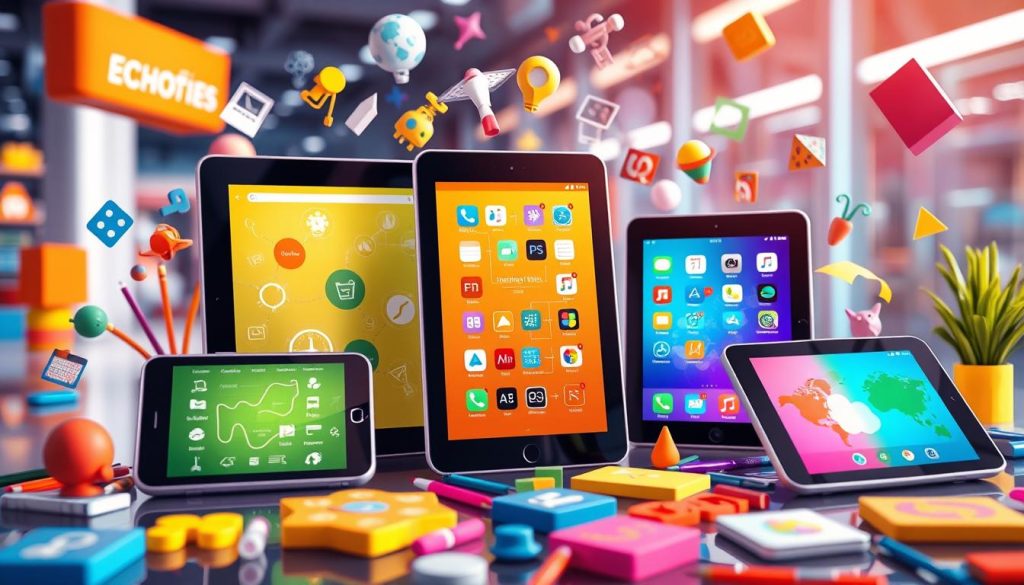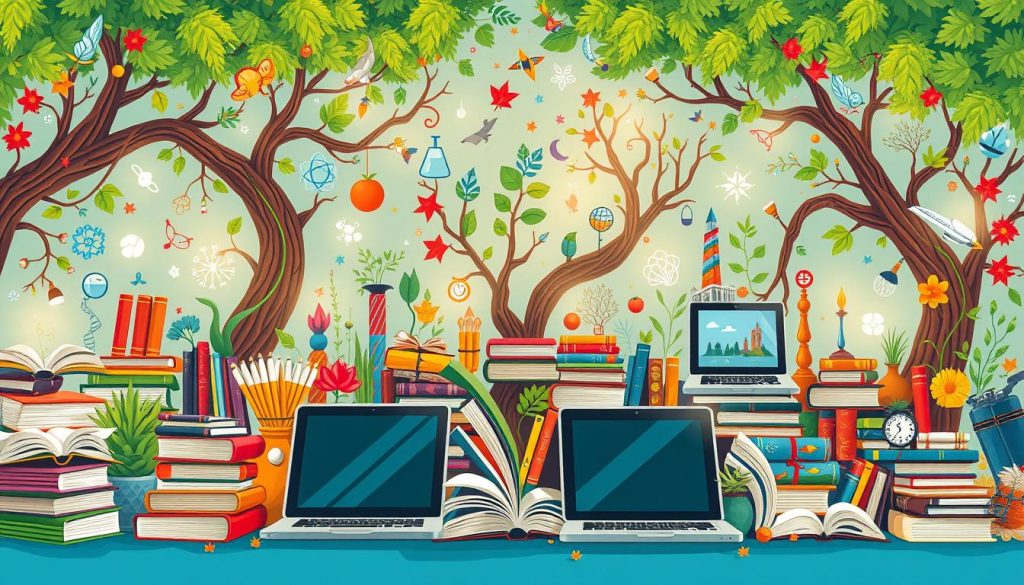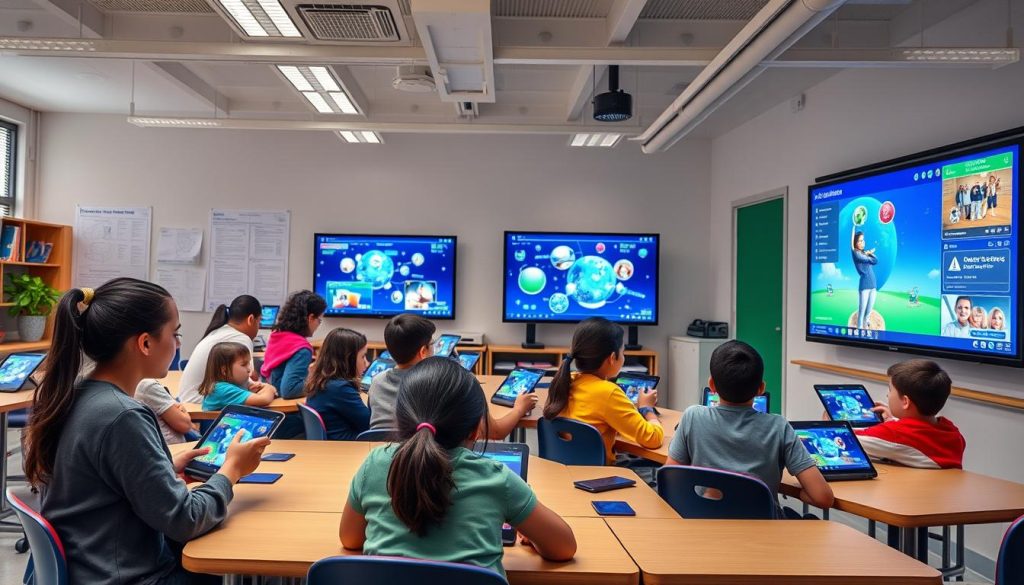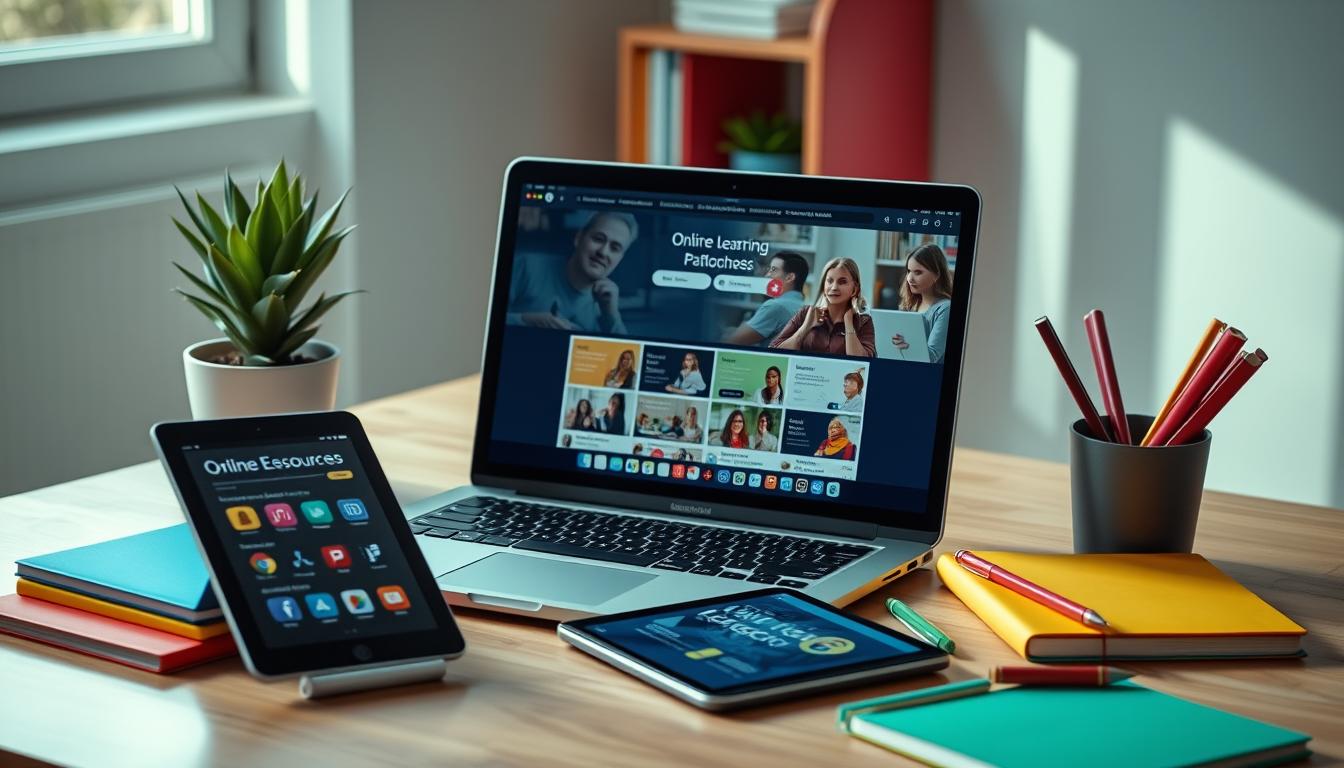I’m excited to share a world of educational resources that can change your learning journey. In this guide, I’ll show you the best e-learning materials and online courses. We’ll look at top platforms and interactive tools to boost your knowledge and skills.
Whether you’re a student, professional, or lifelong learner, these resources will open new doors for you. Get ready to dive into a sea of learning opportunities that fit your unique needs and interests. Let’s start this adventure together and unlock your full potential!
Understanding the Power of Online Learning Platforms
Online learning platforms have changed education. Now, anyone with internet can learn. These platforms offer many courses, making learning fun and engaging.
Coursera: A World of Knowledge at Your Fingertips
Coursera works with top schools to offer quality courses. You can learn about computer science or humanities. It has free and paid options, including degrees.
edX: University-Level Courses for Everyone
edX was started by Harvard and MIT. It brings top education to everyone. You can learn from all over the world, from data science to literature. Many courses are free, with paid options for certificates.
Khan Academy: Free Education for All Ages
Khan Academy is free for everyone. It helps students from elementary school to college. It focuses on STEM and has short videos and exercises to make learning fun.
| Platform | Cost | Specialties | Certification |
|---|---|---|---|
| Coursera | Free-$399/month | University partnerships | Yes |
| edX | Free-$300/course | Ivy League content | Yes |
| Khan Academy | Free | K-12 and early college | No |
These platforms show how tech can make learning easy and flexible. Whether you’re learning for fun or to advance your career, there’s a lot to discover online.
Leveraging Digital Libraries for Academic Success
Digital libraries have changed how I do research and learn. They offer a huge amount of knowledge online. This makes it easy to find scholarly materials from anywhere, anytime.
Digital libraries have a lot of materials. I can find rare manuscripts to the latest research papers. They are all organized and easy to search. This saves me a lot of time when I’m studying or working on projects.
Many digital libraries work with academic databases. This makes research easier. I can check sources, track citations, and find more information. This helps me do better research and keep up with new ideas in my field.
- 24/7 access to resources
- Advanced search capabilities
- Multimedia content integration
- Collaboration tools for group projects
Digital libraries also have open educational resources (OER). These are free materials like textbooks and interactive modules. They have changed how I learn. OER lowers costs and offers different views on subjects.
Using digital libraries has made me better at research and school. They are convenient, have lots of resources, and offer new features. These platforms are key for anyone serious about learning or research today.
Exploring Interactive Tutorials and Simulations
Interactive tutorials and simulations have changed how we learn. They make hard subjects fun and easy to get. I’ve found some top resources that mix fun with learning.
PhET Interactive Simulations: Making Science Come Alive
PhET offers free science and math simulations. They make hard ideas easy to understand. Students can change things and see how it works right away. It’s great for those who learn best by doing.
Code.org: Learn Coding Through Fun Exercises
Coding can seem scary, but Code.org makes it simple. Their tutorials use games and characters to teach coding. It’s a great way for anyone to start coding.
Duolingo: Gamified Language Learning
Duolingo makes learning languages fun. It uses short lessons to teach words and grammar. It’s easy to fit into your daily routine. It’s a fun way to learn a new language or improve your skills.
These tools show how powerful educational technology is. They make learning fun and effective. By using these tools, students can learn at their own pace and explore new subjects.
Harnessing the Potential of Educational Apps

Educational apps have changed how we learn. They bring a world of knowledge right to our phones. This makes learning easy and fun, covering many subjects and learning styles.
As e-learning grows, so does how we learn. Many apps use games to make learning fun. This keeps users excited and helps them keep learning.
Some popular educational apps I’ve tried include:
- Duolingo for language learning
- Photomath for solving math problems
- Quizlet for creating flashcards and study sets
- Kahoot! for interactive quizzes and games
These apps let us learn anytime, anywhere. They’re great for students or adults wanting to learn new things.
Using educational apps in our learning can make it more exciting and personal. I’m looking forward to seeing how these tools will change learning in the future.
Navigating Virtual Classrooms and Webinars
Virtual classrooms have changed education, making online courses available to learners everywhere. I’ve looked into popular platforms that use educational technology to create engaging learning spaces.
Zoom: The Go-To Platform for Online Classes
Zoom is a top choice for virtual classrooms. It’s easy to use, letting teachers host interactive sessions and share screens. The whiteboard feature is great for explaining tough concepts.
Google Classroom: Streamlining Remote Learning
Google Classroom works well with other Google tools, making it a hit with teachers. It makes it easy to share assignments, grade work, and give feedback. It keeps course materials organized, helping students stay on track.
Microsoft Teams: Collaborative Learning Made Easy
Microsoft Teams is a full-featured platform for virtual classrooms. It combines video calls, file sharing, and teamwork tools in one spot. Its connection with Office 365 boosts productivity for teachers and students alike.
| Platform | Key Features | Best For |
|---|---|---|
| Zoom | Breakout rooms, Whiteboard | Large online classes |
| Google Classroom | Assignment management, Google integration | K-12 education |
| Microsoft Teams | Office 365 integration, Collaboration tools | Higher education, Corporate training |
These platforms have changed education, making learning more flexible and accessible. As educational technology keeps improving, I’m looking forward to seeing how virtual classrooms will improve learning even more.
Unlocking Knowledge with Open Educational Resources (OER)

Open educational resources (OER) are changing education. They are free and open, giving everyone access to knowledge. I’ve looked at many OER platforms and found them very useful for learning.
OER cover many subjects like math, science, literature, and history. They come in different formats like textbooks, videos, and interactive simulations. What makes OER special is that teachers can change and adapt them to fit their classes.
- OpenStax: Free, peer-reviewed textbooks
- OER Commons: A digital library of teaching and learning materials
- MIT OpenCourseWare: Full courses from MIT available online
Using OER has many benefits. They save students money, provide current information, and can be customized. I’ve seen how OER can make education fairer, giving everyone quality learning materials.
| OER Type | Examples | Benefits |
|---|---|---|
| Textbooks | OpenStax, BC Campus | Cost savings, customizable content |
| Courses | MIT OpenCourseWare, Saylor Academy | Access to university-level education |
| Multimedia | Khan Academy, PhET Simulations | Interactive learning experiences |
By using OER, we’re not just getting free content. We’re joining a global effort to make education available to everyone. These resources help learners and teachers, promoting innovation and teamwork in education.
Mastering Academic Databases for Research
Academic databases are key for students and researchers. They offer access to scholarly articles and deep research. Let’s look at some top platforms to boost your studies.
JSTOR: A Treasure Trove of Scholarly Articles
JSTOR is a digital library with millions of academic journals, books, and primary sources. It covers many subjects, from history to math. Its easy-to-use interface makes finding materials simple.
Google Scholar: Your Gateway to Academic Literature
Google Scholar is my first choice for quick searches. It’s free and easy to use, offering a wide range of scholarly literature. Its citation tools and library links are very helpful.
ProQuest: Comprehensive Research Solutions
ProQuest has a huge collection of dissertations, theses, and academic journals. Its subject-specific databases are great for focused research. It’s perfect for both current and historical content.
| Database | Content Type | Accessibility | Best For |
|---|---|---|---|
| JSTOR | Journals, Books, Primary Sources | Subscription-based | Humanities, Social Sciences |
| Google Scholar | Articles, Theses, Books | Free | Broad Research, Citation Tracking |
| ProQuest | Dissertations, Journals, Newspapers | Subscription-based | In-depth Research, Historical Content |
These databases have changed my research for the better. They make it more efficient and thorough. By learning these digital libraries, you’ll have access to a wealth of educational resources.
Embracing Educational Technology for Enhanced Learning

Educational technology is changing how we learn. I’ve seen how e-learning materials and interactive tutorials make classrooms better. These tools make learning fun and easy for students of all ages.
E-learning materials offer flexibility and convenience. Students can learn anytime, anywhere. This freedom lets them learn at their own pace and on their own schedule.
Interactive tutorials make learning hands-on. They help students understand better. For example, virtual labs let students do experiments safely from home.
| Tool Type | Benefits | Examples |
|---|---|---|
| E-learning Platforms | 24/7 access, self-paced learning | Coursera, edX |
| Interactive Tutorials | Hands-on practice, immediate feedback | Code.org, Duolingo |
| Virtual Reality | Immersive experiences, spatial learning | Google Expeditions, Labster |
By using these technologies, we get students ready for the digital world. They learn important skills like digital literacy and adaptability. The trick is to use these tools wisely in our teaching.
Maximizing Learning with Multimedia Resources
In today’s digital age, multimedia resources have changed how we learn. Mixing visuals and sounds helps us understand and remember better. Let’s look at some top platforms for educational resources and interactive tutorials.
YouTube EDU: Video Lessons on Every Topic
YouTube EDU is a treasure trove for learners of all ages. It has a huge collection of video lessons on everything from math to literature. Its easy-to-use interface makes finding topics simple. Plus, many universities and schools post their lectures here, offering top-notch courses for free.
TED-Ed: Thought-Provoking Educational Content
TED-Ed brings learning to life with animated videos. These short, engaging clips make complex topics easy to grasp. I love how TED-Ed sparks curiosity and encourages thinking. It’s perfect for students and lifelong learners looking to learn more.
PBS Learning Media: Quality Educational Videos and Interactives
PBS Learning Media is known for its wide range of educational resources. It has videos, interactive tutorials, and lesson plans. Its content is well-researched and meets curriculum standards. It’s a great tool for both teachers and students, offering fun materials in many subjects.
| Platform | Key Features | Best For |
|---|---|---|
| YouTube EDU | Vast library, University lectures | All learners |
| TED-Ed | Animated videos, Thought-provoking content | Curious minds |
| PBS Learning Media | Curriculum-aligned, Interactive resources | Students, Educators |
Using these multimedia platforms makes learning more fun and effective. Whether you need in-depth courses or quick tutorials, these resources meet different learning needs and styles.
Tailoring Your Learning Experience with Adaptive Technologies
I’m excited to explore how adaptive learning technologies are changing the game in education. These smart systems use data and AI to create custom learning paths for each student. It’s like having a personal tutor who knows exactly what you need!
Adaptive e-learning materials adjust to your pace and style. They figure out where you’re struggling and give you extra help. When you’re breezing through, they challenge you more. This way, you’re always learning at the right level.
Educational apps are getting smarter too. They track your progress and suggest new topics based on what you’ve learned. Some even use games to make learning fun. With these tools, you can turn any moment into a chance to grow your skills.
The best part? This educational technology works for all ages and subjects. Whether you’re studying math, languages, or coding, there’s an adaptive system ready to help. It’s an exciting time to be a learner, with so many ways to tailor your education to fit you perfectly.
